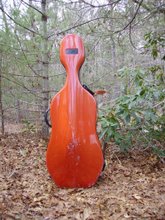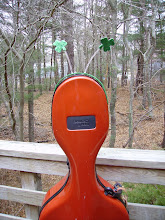I like the Suzuki method. It seems to work for me. I generally like the pieces. I supplement the Suzuki method with lots of other music and etudes, but I sometimes wonder why the Suzuki folks don't increase their product line. Well, I tend to buy a lot of music and related items, and perhaps others might. Here are some of my thoughts.
1. Information on the composers and works included in the Suzuki books. Some of the pieces are excerpts from longer works, and it would be nice to have more understanding of the pieces.
2. Learing CDs with music played at speeds closer to the student's learning and performance speeds. (this seems to be available for violin)
3. More and better ensemble music, not just the same pieces with all the melody in part 1, or with 2nd and 3rd parts that are more difficult.
4. An adult-beginner oriented guide, perhaps with practice tips, memorizing tips, chamber music ideas, setting goals, etc.
(more tomorrow, as it is late)I would love to hear ideas from others.
Subscribe to:
Post Comments (Atom)












5 comments:
I'm currently rereading "The Suzuki Approach" by Louisa Behrend. Originally written in 1971 and updated in 1997, it gives a (somewhat defensive) overview of the Suzuki method. It does acknowledge several shortcomings, such as inadequate musical theory and reading training, limited repertoire, with a narrow style and lack of emotional depth.
My own gripe (I'm at the end of Book 2), is the quality of the recordings. The cello part is OK (from what I can hear of it), but it is often drowned out by the tinny piano. I'd really like to be able to work from a slowed-down recording of these pieces without the piano - just the cello. After all, that's what I'm playing at home.
The piano section would be fine, too, once I've reached that level, but for the initial learning, something more is needed - at least for this adult.
Good, thought provoking topic...
One more thing: A companion guide that clearly explains what technical skill is presented in each lesson, along with some recommendations of appropriately graded companion pieces that help practice this same skill. Rick Mooney does offer some supporting materials, but there doesn't appear to be any real piece-by-piece correlation.
Yes, most definitely, as Guanaco mentioned, the addition of technical material, with more exercises would be helpful. An explanation of some of the symbols that they use, especially those arrow things, would also be helpful.
Can anyone fully explain Suzuki's use of the dot AND line above the note? (See for example Book 1, No. 8, "Allegro") It's not staccato, it's not tenuto. So...?
Guanaco and Donna,
Thanks for your comments. I love the idea of a companion guide, especially for adults, and more clearly relating the Rick Mooney books. The Suzuki method (and I have not read as much as I should have on the method--I find the Suzuki books so uninteresting!) seems to depend a lot on the teacher, and teachers have various approaches to teaching this material.
The arrow things indicate a shift--I am thinking of the second page (in A major) of La Cinquitaine, where there is an arrow over the G#, to indicate that you move the whole hand down.
The staccato/tenudo is a standard marking, not one invented by Suzuki, but I don't even remember its use in Allegro. I play that staccato. I think it is a little longer than a staccato, but someone else may be better able to explain it.
I would also like just a cello CD without the piano. I even asked my teacher to make a recording.
More complaints later. I am still a little disorganized, away from home.
Post a Comment